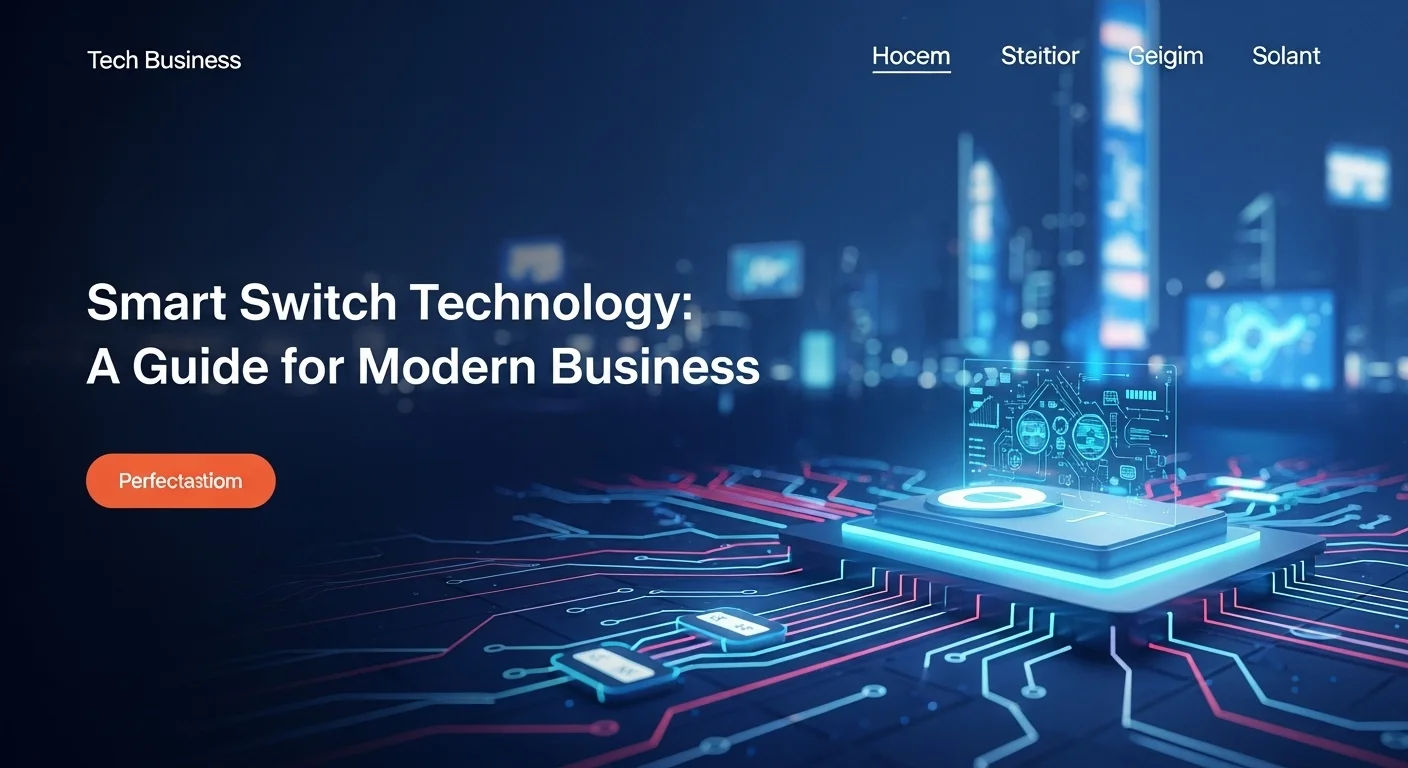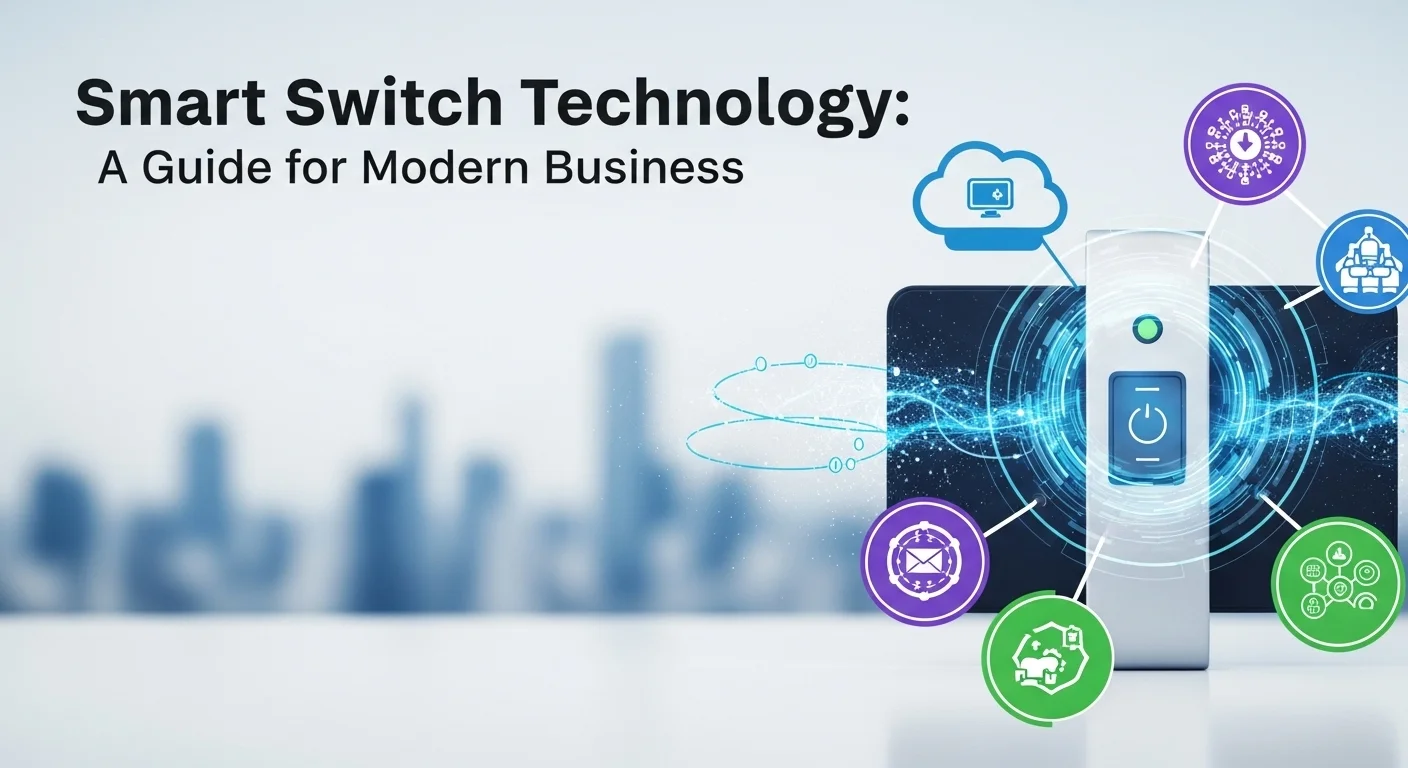Smart Switches Explained: Your Guide to a Smarter Home and Business

Executive Summary
Over the years, I've seen countless tech trends come and go, but one of the most practical and powerful upgrades you can make is surprisingly simple: the smart switch. These devices look like your standard wall switch but have a secret superpower—they connect to your network. This simple change unlocks a world of remote control, automation, and flexibility. For businesses, this is a game-changer. I've seen companies slash energy bills by scheduling lights to turn off automatically and create the perfect mood in shops and restaurants to welcome customers. For those of us at home, it's about convenience, better security, and saving a little money on electricity. You can control a smart switch from your phone, with your voice, or set it up to work with other smart gadgets. This technology is no longer just for tech enthusiasts; it's becoming a fundamental part of any modern, intelligent building. Understanding what they can do is the first step toward a more connected and efficient future.
Table of Contents
What is a Smart Switch and Why Does It Matter?
In the world of smart technology, the smart switch has become a quiet hero for both homes and businesses. At its heart, a smart switch does the same job as the traditional switch on your wall, but it's built with brains. It connects to your network (usually via Wi-Fi, Zigbee, or Z-Wave), which lets you control it remotely and set up all sorts of automations. [1, 3] Here's a key point I always stress to people: unlike a smart bulb, which puts the intelligence in the bulb itself, a smart switch makes the entire circuit smart. That means any light connected to it—no matter how 'dumb' the bulb is—can now be controlled intelligently. This is a huge deal for scalability. Imagine trying to replace every single light bulb in an office building; it would be a nightmare. Replacing the switches is far more practical and cost-effective. But its importance goes way beyond just turning lights on and off from your phone. [4] Smart switches are the missing link between a building's physical wiring and its digital brain. For businesses, this opens up incredible opportunities for efficiency. I've personally seen projects where implementing an intelligent lighting system led to massive cuts in energy consumption. [16] Think of an office where lights automatically shut off in empty meeting rooms, or a store where the lighting changes throughout the day to match customer flow and create a welcoming atmosphere. [20] This isn't science fiction; it's happening right now and delivering a real return on investment. The security benefits are also very real. A smart switch can be programmed to turn lights on and off randomly when you're away, making it look like someone's home—a simple but effective way to deter potential intruders. [5, 21] For people with mobility issues, being able to control lights with their voice or a simple tap on an app is a life-changing improvement. At the end of the day, the smart switch is a perfect example of the Internet of Things in action: taking an everyday object and making it connected, responsive, and incredibly useful.
The Big Question: Smart Switch or Smart Bulb?
When people first dip their toes into smart lighting, they always ask me: 'Should I get a smart switch or smart bulbs?' It's a great question, and the answer depends on how they work. A smart bulb is a self-contained unit; all the tech is packed right inside. It’s super easy to get started—just screw it in and connect it to an app. But there's a catch I've seen frustrate so many people: the wall switch must always be left on. If someone flips that switch off by habit, your smart bulb loses power and becomes a 'dumb' bulb again. It won't respond to any command until you flip the switch back on. In a house with family or an office with colleagues, this can be a constant headache. Plus, if you have a fixture with four bulbs, you need to buy and set up four separate smart bulbs, which gets expensive fast. A smart switch, on the other hand, puts the intelligence at the wall. It controls the power going to the entire fixture. This lets you use any standard lightbulb you want. The switch on the wall still works like a normal switch for anyone who uses it, but it also has that layer of smart control. For that same four-bulb fixture, you only need one smart switch. It's cleaner, often cheaper in the long run, and just more intuitive for everyone. For any serious smart lighting project, especially in a new home or during a renovation, I almost always recommend starting with the switches. It creates a more reliable and user-friendly foundation for your entire smart home.
Real-World Business Benefits and ROI
This is where smart switch technology truly shines and shows its financial muscle. Commercial buildings are famous for wasting energy, and lighting is a huge part of that expense. An intelligent lighting system gives you the power to fix that. In an office, for example, you can pair smart switches with motion sensors so that lights are only on when a room is actually being used. [1] I've seen companies save a fortune by doing this in conference rooms, private offices, and restrooms that sit empty for hours. More advanced systems can even use 'daylight harvesting,' where the lights automatically dim when there's enough sunlight coming through the windows. The combined savings across a large building can be staggering, leading to lower bills and a smaller carbon footprint. [11] In retail and hospitality, the benefits go beyond just saving money; they improve the customer experience. A restaurant manager can program different lighting 'scenes'—maybe bright and lively for lunch, and warm and romantic for dinner—and switch between them with one tap. [20] A hotel can set up a room's lights to create a welcoming glow when a guest first walks in, and then automatically turn everything off when they leave. These touches make a business feel more modern and run more smoothly. Security is another major win for businesses. When you link smart lighting to your security system, it becomes a powerful deterrent. [21] For instance, if a camera detects motion after hours, the system can flood the area with light, startling the intruder and giving you a much clearer video recording. [25] The 'vacation mode' that mimics activity is just as useful for a small shop as it is for a home, making the property a less attractive target. [29] When businesses look for a solution, they need something robust, scalable, and secure enough for a commercial setting. The investment in a smart building lighting system pays for itself through energy savings, a better customer experience, enhanced security, and more streamlined operations.

A Complete Guide to Smart Switch Technology and Business Solutions
Getting into smart switches is more than just buying a device; it's about planning. Whether you're a homeowner excited about new tech or a business leader looking for an edge, a little strategy goes a long way. To get a lighting system that works flawlessly, you need to think about your current wiring, pick the right way for your devices to talk to each other, lock down security, and tap into the power of a connected ecosystem. This guide will walk you through the practical steps and critical choices. It all starts with the wires in your wall—something many people overlook. Understanding what a 'neutral wire' is can be the difference between a simple install and a major headache. From there, we'll dive into the wireless languages these switches speak, like Wi-Fi, Zigbee, Z-Wave, and the new universal translator, Matter. For businesses, the focus shifts to bigger things: managing hundreds of devices, protecting the company network, and getting a clear return on investment. The needs of a small office are completely different from a multi-story corporate building. Choosing the best system for a business means looking for strong integration with building management systems (BMS), top-notch security, and the ability to use cloud computing and AI to optimize everything. [9] This guide will give you the knowledge to navigate it all, whether you're picking a single switch for your living room or designing a company-wide lighting strategy.
Technical Deep Dive: Wiring, Protocols, and Matter
Before you even think about buying a smart switch, we need to have a quick chat about what’s behind your current switch plate. The single most important thing to know about is the 'neutral wire.' In simple terms, a standard switch just interrupts the power ('hot' wire) to the light. A smart switch, however, needs a little bit of power all the time to keep its radio on and stay connected to your network. The neutral wire provides this continuous power. [5] Many homes built before the 1980s don't have this wire in the switch box, which can limit your options. While some 'no-neutral' switches are available, they're less common. The other thing to check is if you have a '3-way' switch setup, where two or more switches control the same light (like at the top and bottom of stairs). For these, you'll need a specific smart switch and a companion switch designed to work together. Once you've figured out the wiring, it's time to choose the wireless protocol. This decision affects how reliable and fast your system is.
Wi-Fi: This is the simplest option. These switches connect directly to your home or office router, no extra hardware needed. [4] It's great for getting started or for a small number of devices. The downside? If you have too many Wi-Fi gadgets, you can clog up your network, potentially slowing things down. It's like having too many people trying to talk at once in a small room.
Zigbee and Z-Wave: These are my personal favorites for larger setups. They are low-power networks designed just for smart devices. Their best feature is creating a 'mesh network,' where each powered device acts as a signal repeater, making the network stronger and more reliable as you add more devices. [7] This is fantastic for larger homes or offices. The only catch is they require a central hub or bridge to act as a translator between the devices and your Wi-Fi network.
Matter: This is the future, and it's incredibly exciting. Backed by giants like Apple, Google, and Amazon, Matter is a universal standard. The goal is to make all smart devices work together, regardless of the brand. A Matter-certified switch should work with any Matter controller (like an Amazon Echo or Google Nest Hub). This ends the frustration of being locked into one company's ecosystem. It gives you the freedom to choose the best device for the job, knowing it will play nicely with everything else. Matter runs on Wi-Fi and another mesh protocol called Thread, offering the best of both worlds: simplicity and reliability.
Business Solutions: Scalability, Security, and the Cloud
When a business decides to install a smart lighting system, the conversation changes. It's no longer just about convenience; it’s about managing potentially thousands of devices securely and efficiently. Scalability is the first major consideration. The system has to handle a high density of switches without slowing down. This is where dedicated commercial-grade systems using protocols like Zigbee or Z-Wave really outperform standard Wi-Fi. The management software is just as important. Businesses need a central dashboard, usually based in the cloud, that lets a facility manager configure, schedule, and monitor every single switch, even across multiple buildings. [27] This dashboard should provide deep insights into energy use, helping to prove the ROI of the project. [9] However, the most critical piece of the puzzle for any business is security. Every connected device is a potential door into the company network. [34, 42] I can't stress this enough: a cheap, unsecured smart switch system can be a huge liability. It's essential to choose manufacturers who take security seriously, providing features like strong data encryption and regular security updates. A common best practice I always recommend is putting all IoT devices on their own separate network (a VLAN) to keep them isolated from sensitive company data. [15] The cloud plays a central role here. It provides the platform for remote management and analytics, but it's also where the magic of AI comes in. [22, 27] A cloud-based AI can learn a building's traffic patterns to create lighting schedules that are perfectly optimized, saving more energy than a human ever could. [19, 28] When choosing a system for commercial use, you have to look past the switch itself and evaluate the entire platform's power, security, and intelligence.

Tips and Strategies to Improve Your Smart Switch Experience
Getting your smart switches installed is just the beginning. The real magic happens when you turn a bunch of connected devices into a truly smart system that works for you. This means using smart strategies and the right tools to create automations that make life easier and more efficient. For home users, it's about setting up routines that handle daily tasks automatically. For businesses, it's about using data to drive down costs and create a better environment for everyone. In this section, I'll share some of my favorite tips to help you get the most out of your investment. We’ll look at practical automation ideas, the importance of good naming for voice control, and how to combine your switches with sensors and speakers to make your system proactive, not just reactive. We'll also explore how businesses can use lighting data to inform company policy and how AI is creating self-optimizing buildings. [2, 6] By the end, you'll have the tools to make your smart lighting system one of the best upgrades you've ever made.
Home Automation: Best Practices and Creative Ideas
Once your smart switches are in, you can start having some real fun. Here are a few tricks I've learned over the years to make your smart lighting feel effortless:
1. Name Your Lights Intuitively: This is my number one tip for voice control. Be specific. Instead of 'Light 1,' use names like 'Kitchen Ceiling Light' or 'Bedside Lamp.' This makes commands feel natural. Grouping is also a game-changer. Create a 'Living Room' group in your app to control all the lights in that room with one command like, 'Alexa, turn off the living room.'
2. Build Powerful Routines for Your Day: Most platforms let you create 'scenes' or 'routines.' Think about your daily flow and build automations around it.
* 'Good Morning' Routine: When your alarm goes off, your bedroom lights can slowly fade on, the switch for your coffee maker can click on in the kitchen, and your smart speaker can start your morning playlist.
* 'Movie Night' Scene: A single phrase can dim the living room lights to 10%, turn off the lights in the kitchen, and set the perfect mood.
* 'Goodbye' Routine: As you leave the house, one command can turn off every light, adjust the thermostat, and arm your security. You can even automate this using your phone's location (geofencing). [25]
3. Use Sensors for Hands-Free Automation: The best smart system is one you don't have to think about. Motion sensors are key. Put them in hallways, bathrooms, and closets so lights turn on when you walk in and—just as importantly—turn off after you leave. [1] It’s both convenient and a fantastic energy saver. You can also use door sensors; for example, opening the pantry door can automatically turn on the pantry light.
4. Don't Forget 'Vacation Mode': This feature is a simple but powerful security tool. [29] It intelligently randomizes when your lights turn on and off to create a realistic impression that someone is home, which is far more convincing than leaving one light on a basic timer. [21]
5. Get Creative with IFTTT (If This Then That): For those who love to tinker, a service like IFTTT can connect your lighting to hundreds of other apps. You could have a light flash when your favorite team scores a goal or have your porch light turn on when your Uber arrives. The possibilities are virtually endless.
Advanced Business Strategies and the Future of Smart Lighting
For a business, a smart lighting system is a source of invaluable data. To truly maximize its worth, companies need to think beyond simple on/off schedules.
1. Use Data to Manage Energy: Commercial systems provide incredible detail on energy use, right down to a single switch. [9] I advise facility managers to review this data regularly. It helps you spot problems—like a whole department's lights being left on all weekend—and provides hard numbers to show the success of your sustainability efforts. [28]
2. Integrate with Other Building Systems: The real power is unlocked when lighting talks to other systems. [10] For instance, by linking lighting to the HVAC, the system knows that if all the lights in a zone are off, it's likely empty and the air conditioning can be scaled back. For safety, you can link it to the fire alarm to automatically turn all lights to 100% brightness during an evacuation, improving visibility. [24]
3. Embrace Artificial Intelligence (AI): The future is in predictive buildings. AI algorithms can analyze a building's usage patterns over time, learning the difference between a busy Monday and a quiet Friday. [19] The AI can then create perfectly optimized lighting schedules that are far more efficient than anything a human could program, maximizing savings without anyone noticing a difference. [2, 6]
4. Look into Human-Centric Lighting: This is an exciting new frontier. The idea is to have your lighting mimic the natural patterns of the sun to support well-being. A smart system can change the color temperature of the lights during the day—a cool, blueish light in the morning to boost energy, shifting to a warm, yellowish light in the afternoon to help people wind down. [28] In offices, this has been linked to better productivity and happier employees. [20]
By adopting these advanced strategies, a business can turn its lighting from a simple expense into a dynamic, intelligent asset that saves money and creates a safer, more productive environment. For more on securing these complex systems, I often point clients to expert resources, like the advice published by the Forbes Technology Council. [42] It's this kind of holistic approach that ensures technology serves your long-term goals.
Expert Reviews & Testimonials
Sarah Johnson, Business Owner ⭐⭐⭐
The information about Smart Switch is correct but I think they could add more practical examples for business owners like us.
Mike Chen, IT Consultant ⭐⭐⭐⭐
Useful article about Smart Switch. It helped me better understand the topic, although some concepts could be explained more simply.
Emma Davis, Tech Expert ⭐⭐⭐⭐⭐
Excellent article! Very comprehensive on Smart Switch. It helped me a lot for my specialization and I understood everything perfectly.



